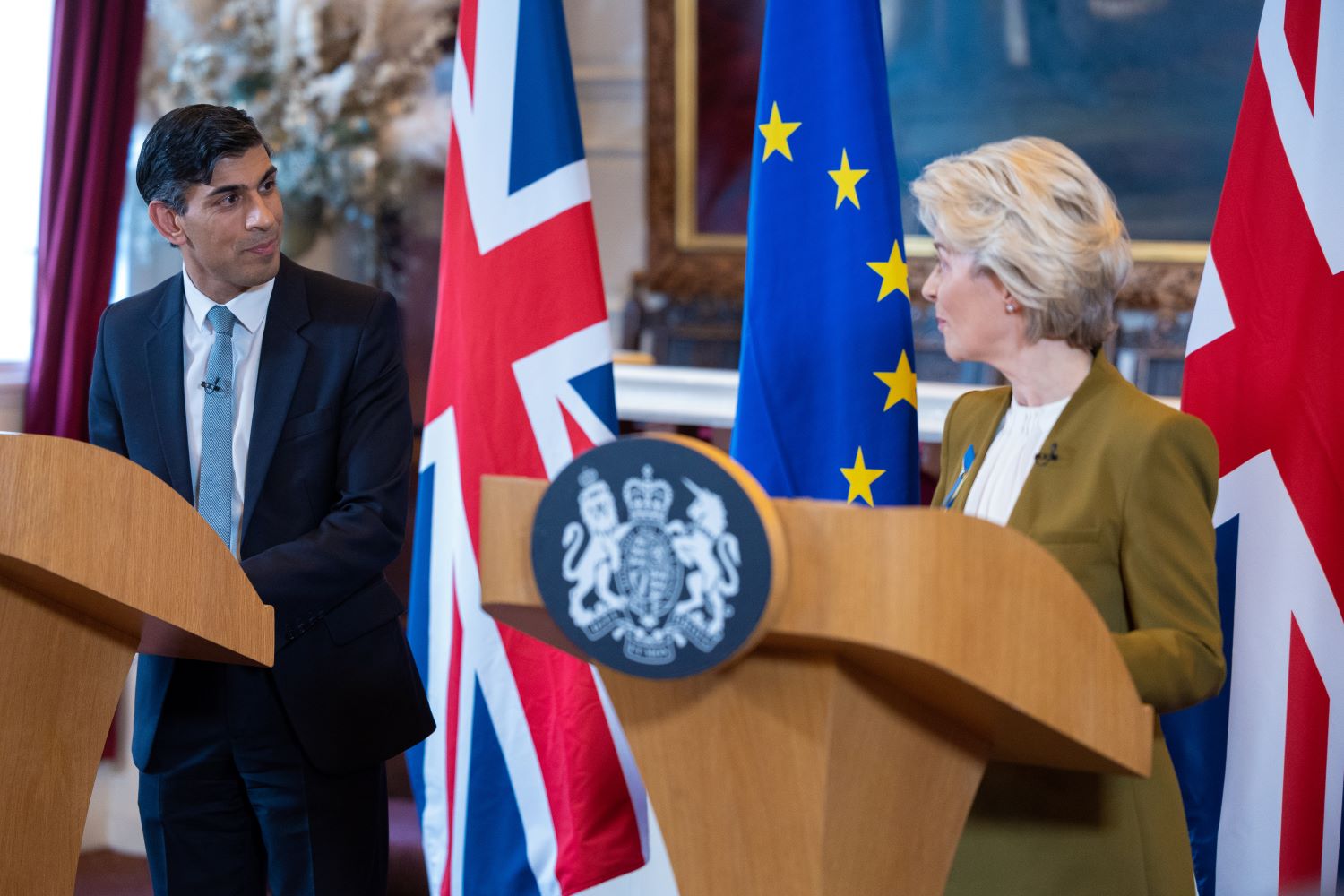Seven years on, we now have considerable perspective on the policy challenges and dilemmas posed by Brexit. Patrick Diamond and Jeremy Richardson outline four concepts that can help make sense of the predicament Brexit has led to and explain why finding ways to overcome them creates so many headaches for policy-makers.
This article is part of our series on policymaking in the UK after Brexit. For more analysis, visit the focus page.
Richardson and Rittberger, in analysing the causes of Brexit, argued that the British political elite presided over a policy process that was an “omnishambles” of monumental proportions. Office holders lost the ability to steer, let alone control, the policy process, with little or no understanding of what the short-term or long-term outcome would be. Perhaps the greatest paradox of Britain’s decision to leave the EU is that, though the process itself has been an omnishambles, the actual decision was undoubtedly a critical juncture in British post-war politics, quite possibly the most consequential policy decision since Britain joined the then European Community in 1973.
In practice, “the European question” has often dominated post-war British politics and has produced two critical junctures of historic proportions: first to step on the escalator of European Integration in 1973, and then in 2016 deciding to get off the escalator. The problem for policy-makers is that it is extremely difficult to predict how a critical juncture will pan out over time.
Moreover, it is important to grasp the temporal dimension of the Brexit process, as change has unfolded over time. After the 1973 critical juncture, it took many years for British policy-making to become fully Europeanised. Far from being “the awkward partner” within the EU, Britain became one of the most effective European players, both in terms of adapting its domestic machinery of government to European membership and being one of the most admired players in the complex Brussels policy games. The British Government’s adaptation to the EU rules of the game was matched by the sheer professionalism of British interest groups as lobbyists in Brussels. As time wore on, Britain became adept at espousing and benefitting from those European policies that suited its interests, while sometimes opting out of those that it found objectionable. To a considerable degree, therefore, Britain managed to have its cake and eat it.
However, we argue that there were certain features of the Brexit decision itself, combined with structural characteristics of the current British policy-making process, that will present huge challenges in the post-Brexit era. These challenges are as likely to perpetuate stagnation and stasis as they are to produce far-reaching successful policy change. We base our argument on four concepts drawn from classis theories of policy-making, namely the notion of policy frames; the law of large solutions; the law of unintended consequences; and the concept of government overload.
The power of framing
We begin with what, in hindsight, is at the root cause of the Brexit problem: the way in which Brexit was “framed” from the outset. Ideas are powerful and consequential in politics, yet for ideas to get traction in public debate, they need to be simple to understand and easily communicated. Ideas and policies are linked via “policy frames” which heavily influence the way policy-makers view policy problems. Once policy-makers are wedded to a particular policy frame, it then shapes subsequent policy choices (and, as in the case of Brexit, can marginalise hitherto important policy actors such as business interests, environmentalists, women’s groups, and trade unions).
Membership of the EU was, on the face of it, a simple idea, as straightforward as joining any club voluntarily. However, the EU is not any old club. Its policy remit runs so wide that it is possible to see it as a “policy-making state”. A significant proportion of Britain’s public policy and regulatory landscape was in reality “EU-made” public policy. It was not “made in Britain”. Herein lies the core of the problem of EU withdrawal now facing the UK.
The post-Brexit central problem is that Britain was deeply embedded in the EU. In reality, leaving the EU has been like trying to unscramble a huge omelette.
The Brexit policy frame was perfectly simple: “break free and regain national sovereignty”. The post-Brexit central problem is that Britain was deeply embedded in the EU. In reality, leaving the EU has been like trying to unscramble a huge omelette. Brexit was a very simple policy frame, easy to sell. Moreover, the over-arching frame (“regain our sovereignty”) was underpinned by an even simpler (but equally erroneous) frame which Glencross terms “cakeism”, by which he means “the notion that the UK could keep certain benefits or not suffer costs after Brexit”. In short, the Brexiteers thought, wrongly, that having one’s cake and eating it would continue as before.
The law of large solutions
The Brexit policy frame has, inevitably, run up against the law of large solutions in public policy. This “law” was developed by Aaron Wildavsky four decades ago, when he was puzzling over why public policies failed so often. His answer was simple (and correct!): it was, “because the Law of Large Solutions in Public Policy – when the solution dwarfs the problem as a source of worry – is inexorable”. Wildavsky’s central thesis was that public policy solutions themselves become perplexing – and even bigger – problems. He believed this phenomenon to be especially true for big policy problems since they usually, “create solutions so large that they become the dominant cause of the consequences with which public policy must contend”. Brexit is undoubtedly a classic example of the law of large solutions.
The Retained EU Law Bill (REUL) goes to the heart of the UK’s post-Brexit policy dilemma and illustrates the sheer scale of the policy problems which the Brexit process has created. The British Government must decide what to do about a swathe of legislation and regulations that have accumulated during 50 years of UK membership of the EC/EU. The post-Brexit challenge is to decide, firstly, how much of this EU legislation should be jettisoned; and secondly, to determine the specific content of post-Brexit public policy. The second issue is that the quantity of legislation related to REUL is unknown. The Government has identified around 2,420 legislative items; however, some researchers estimate that there may be more than 5,000 separate pieces of legislation that fall within the scope of REUL.
The post-Brexit challenge is to decide, firstly, how much of this EU legislation should be jettisoned; and secondly, to determine the specific content of post-Brexit public policy.
The law of united consequences
Alas, we know that policy-making even in normal times is subject to the “law of unintended consequences”. Policy implementation rarely goes smoothly, even with carefully designed policies. It is no surprise, therefore, that post-Brexit Britain has seen many examples of unintended (and unwelcome) consequences of EU withdrawal. To take an obscure example: did anyone foresee that Brexit could have adverse effects on Britain’s world-leading Grand Prix industry? Yet the effects were sufficiently serious for the seven British-based Formula One teams to meet the prime minister to argue for the easing of post-Brexit border crossing and permit problems. The issues of nuclear safeguards and radiation policy after Brexit present the same challenges as those facing the Grand Prix industry. It is serious that problems moving Grand Prix parts around Europe might eventually threaten an industry that employs 40,000 people in the UK, but this problem pales in comparison to managing efficiently, and safely, our nuclear safeguards and radiation policy.
Government overload
Finally, we return to the age-old question about British government in the light of Brexit: is it now simply so overloaded that it is unable to function effectively? The father of the overload thesis, Anthony King, was deeply pessimistic when he wrote his classic analysis in the 1970s, Overload: Problems of Governing in the 1970s. His argument was clear cut: “Let us begin by reminding ourselves of some of the indications that the business of government in Britain has become more difficult. The number of such indications is vast”. The overload problem is likely to be much worse decades after King wrote his seminal piece on government overload. The Brexiteers created excessive and unrealistic expectations amongst citizens. That voters are now increasingly disillusioned is of little surprise.
All in all, the UK government is as divided over Brexit as ever: it faces a monumental policy task in deciding what to do with thousands of EU public policies; and, to top it all, the (now reconfigured) populist revolt has the potential to intensify in the years ahead as the failure to deliver on popular expectations of withdrawal from Europe becomes ever more evident. Brexit remains a critical juncture in British politics, but the Westminster Government has, so far, been unable to fulfil its objective of enacting Brexit as a critical juncture that would transform UK politics and policy-making. In short, the British governing class is confronting a polycrisis of its own making.
This post draws on the findings of the recent research article “The Brexit Omnishambles and the law of large solutions” (Journal of European Public Policy, 2023)
All articles posted on this blog give the views of the author(s), and not the position of LSE British Politics and Policy, nor of the London School of Economics and Political Science.
Image credit: Shutterstock







